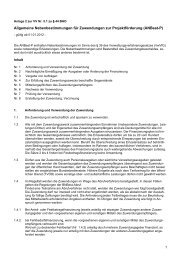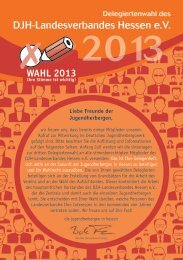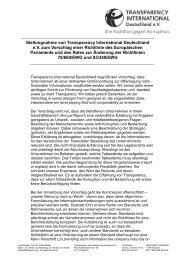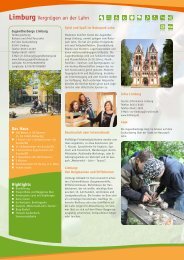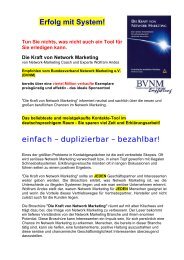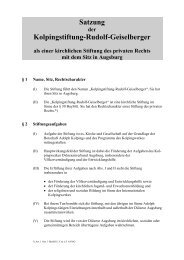REPA Booklet - Stop Epa
REPA Booklet - Stop Epa
REPA Booklet - Stop Epa
You also want an ePaper? Increase the reach of your titles
YUMPU automatically turns print PDFs into web optimized ePapers that Google loves.
pushing; and difficulties in ‘stabilising’ trade and investment policies to provide better guarantees for businesses<br />
and investors.<br />
“Talk of regions as<br />
merely ‘regional trade<br />
arrangements’ is<br />
contemptuous as it<br />
reduces the millions of<br />
poor people in these<br />
countries to nothing.<br />
There is more to<br />
regions than just trade<br />
and markets. Justice<br />
demands that the lives<br />
of people of the South<br />
should not be<br />
subjected to this<br />
narrow examination.”<br />
(Percy Makombe,<br />
SEATINI, 2004)<br />
How would the European Union differentiate within the ACP?<br />
The ‘ultimate objective’ was to conclude Economic Partnership Agreements (EPAs) in each of the 3 ACP regions<br />
by negotiating with subgroups of countries that were already involved in a regional economic integration<br />
process. Those subregional arrangements would also take into account their level of development, constraints<br />
and capacities. The Commission said ‘of course’ it was for the ACP countries to choose their own regional<br />
structures. But the mandate went on to identify the likely groupings: West Africa, Central Africa, Southern Africa,<br />
East Africa, the Caribbean and the Pacific; plus a few larger individual countries (code for South Africa). There<br />
was a particular problem with the Pacific, because there was no formal regional economic integration arrangement<br />
and no regional partner for the Commission to negotiate with - hence the Commission’s support for the creation<br />
of the Pacific Island Countries Trade Agreement (PICTA).<br />
What negotiating process and structure did the Europeans have in mind?<br />
The plan was to have two levels of agreement:<br />
1. an overall agreement, negotiated between 1998 and 2000. This would set out the overall objectives<br />
and framework for the regional agreements, name the regional subgroups that would negotiate them,<br />
and set down the negotiating timetable. It would also contain common provisions for ‘trade-related’<br />
areas that could be expanded on later.<br />
2. subregional negotiations (which could eventually be harmonised) for:<br />
- economic cooperation agreements: these would contain an element of reciprocity for EU exports into<br />
the subregion and provide for cooperation in trade-related areas, with a timetable for reviewing their<br />
progress towards further liberalisation; or<br />
- economic partnership agreements: these would provide for the gradual creation of free trade areas<br />
that met WTO requirements (to cover all sectors and substantially all trade within a 10 year period) and<br />
in accordance with the European Union’s Common Agriculture Policy.<br />
When were these subregional agreements supposed to be completed by?<br />
The Commission would seek a waiver from the WTO for a ‘transition’ period of 5 years – meaning the<br />
subregional negotiations were originally supposed to be completed by 2003! The specific timetables for those<br />
negotiations would reflect the state of regional integration arrangements.<br />
What if some ACP States wanted to opt out?<br />
They had two choices:<br />
- Least Developed Countries could take up the Everything But Arms arrangement. This would allow<br />
them duty free access to the European Union for ‘almost all’ goods, except arms. However, the<br />
Europeans could end the scheme unilaterally at any time.<br />
- Other ACP States would still have access to the General System of Preferences (GSP). However, this<br />
meant they would be treated the same as other developing countries and lose their special treatment as<br />
ACP States. They would also have to accept whatever deal the European Union was offering under<br />
the GSP, which could also be altered or withdrawn unilaterally.<br />
Was the Commission’s mandate non-negotiable?<br />
Negotiations with the ACP were one of many competing considerations for the European Union. The mandate<br />
reflected its internal politics, policies and priorities, its geo-political strategy and its objectives in the WTO and<br />
other trade negotiations. The Commission wanted to avoid precedents that could undermine its arguments in<br />
those negotiations and create favourable precedents it could use as leverage. If the ACP Group was going to<br />
force the Commission to reconsider, it would have needed to seize the initiative at the earliest possible stage and<br />
go beyond a critique of the Green Paper to develop clear, credible, principled alternatives that had popular<br />
support within ACP countries and were backed by a strong lobby within Europe.<br />
22<br />
A People’s Guide To The Pacific’s Economic Partnership Agreement



